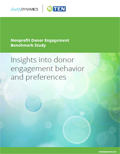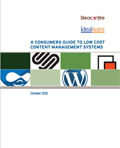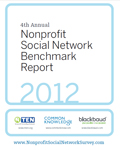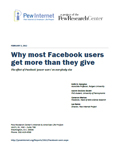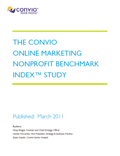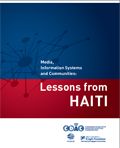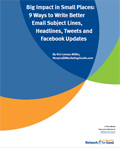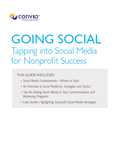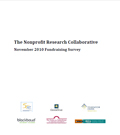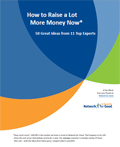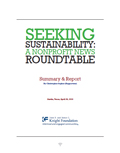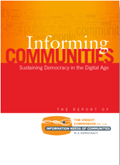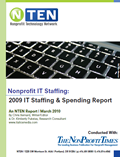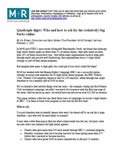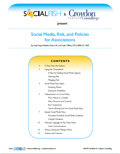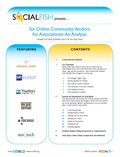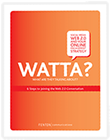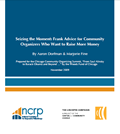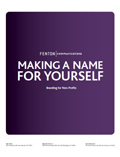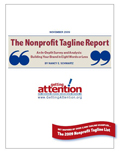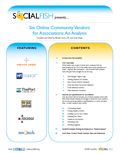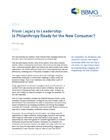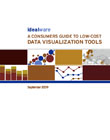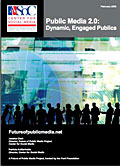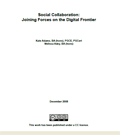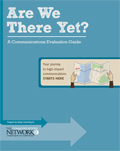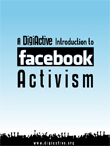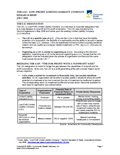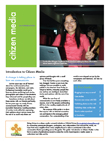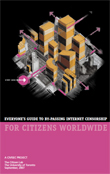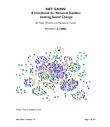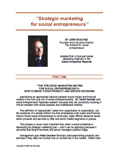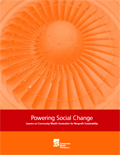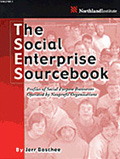Annaliese Hoehling
Publications Director
NTEN
49 pages, April 2013
Since 2006, NTEN has produced the annual Nonprofit Technology (formerly “IT”) Staffing and Investments survey and report for the nonprofit sector. Over 2,600 nonprofit professionals filled out the latest annual survey, providing another year of benchmarks and data concerning: salaries, technology budgets, organizational structure and other aspects of nonprofit technology practices.
Download report (PDF) after you register
NTEN & Charity Dynamics
16 pages, November 2012
This donor-focused study gathered feedback from consumers spanning a wide range of giving levels ($25 – $5,000+) who donated to a nonprofit in the past 12 months. Survey questions sought to understand individuals’ preferences regarding traditional and digital media for donating, volunteering and engaging with nonprofits.
Read summary
Download report (PDF) after you register
NTEN
Idealware
35 pages, November 2012
In April 2012 NTEN worked with Idealware to conduct a survey of nonprofits about their relationships with data, and found a large dichotomy: either they were doing a lot with metrics or not much at all. They also learned that internal factors — such as staff capacity, expertise and budget — as well as external demands and stakeholders — including funders; local, state and federal governments; donors; clients; and community groups — also hinder an organization’s ability to make strategic use of data they have collected.
NTEN & Charity Dynamics
100+ pages, October 2012
This report is a valuable resource for small and mid-sized organizations that are considering options for their CMS solution (for website content management). The report provides some helpful overview for approaching the CMS evaluation process in general as well as some recommendations for making your selection process more focused and effective.
Read summary
Download report (PDF) after you register
Aaron Smith
Pew Internet
15 pages, August 2012
Social networking sites have grown more important in recent years as a venue for political involvement, learning and debate. Overall, 39% of all American adults took part in some sort of political activity on a social networking site during the 2012 campaign. The results in this report are based on data from telephone interviews conducted by Princeton Survey Research Associates International from July 16 to August 7, 2012.
Download report (PDF)
Anthony Carraturo, VP of Lead Generation & Data Services, MeritDirect
Thomas Harpointner, CEO, AIS Media
Andrew Kordek, Chief Strategist and Co-Founder, Trendline Interactive
Tom Scearce, Principal, Falconry Group
Jordie van Rijn, Email Marketing consultant, eMailmonday
4 pages, August 2012
Building up your subscriber list is at the heart of e-mail marketing, so you must ensure that your list is of the highest possible caliber. In this report, other thought leaders join the party to offer their best practices for building an effective subscriber list.
Download whitepaper (PDF)
Annaliese Hoehling
Publications Director, NTEN
54 pages, May 2012
It can often feel like we’re making important investment decisions in the dark. Should we put more resources toward developing a formal technology plan? Will that improve how our organization works on our mission? How many technology staff should we have if our total staff is only five? NTEN’s annual research on nonprofit technology spending and practices sheds light on these questions and many more.
Read summary
Download report (PDF) after you register
Andrea Berry, Laura S. Quinn, Idealware
Lisa Colton, Darim Online
37 pages, April 2012
A good social media policy will provide clear guidelines as to what staff should and shouldn’t do when posting and interacting with the community on a day-to-day basis. The Nonprofit Social Media Policy Workbook is designed to help you and your organization ask the important questions about social media and take the next steps to growing a social culture.
Read summary
Download report(PDF) after you register
NTEN, Common Knowledge and Blackbaud
40 pages, April 2012
This report provides insights for nonprofits, foundations, media and businesses serving the nonprofit sector about the most important behavior and trends surrounding social networking as part of nonprofits’ marketing, communications, fundraising, program and IT work.
Read summary
Download report (PDF) after you register
The International Labour Organization
Johns Hopkins University Center for Civil Society Studies
120 pages, March 2012
This manual is intended to guide countries in generating systematic and comparable data on volunteer work via regular supplements to labor force or other household surveys. The objective is to make available comparative cross-national data on a significant form of work that is growing in importance but that is often ignored or rarely captured in traditional economic statistics.
GrantStation and PhilanTech
33 pages, March 2012
The State of Grantseeking Spring 2012 is the fourth semi-annual informal survey of nonprofits conducted by GrantStation and PhilanTech to reveal the current state of grantseeking in the U.S.
Read summary
Download report (PDF) after you register.
Blackbaud, NTEN and Common Knowledge
40 pages, March 2012
Despite limited budgets and staffing, nonprofits continue to find great value in their fast-growing social networks. This annual report is packed with insights into how nonprofits are leveraging social networks as part of their marketing, communications and fundraising strategies.
Read summary
Download report (PDF) after you register
Keith N. Hampton, Associate Professor, Rutgers University
Lauren Sessions Goulet, Ph.D. student, University of Pennsylvania
Cameron Marlow, Head of data science research, Facebook
Lee Rainie, Director, Pew Internet Project
40 pages, February 2012
Most Facebook users receive more from their Facebook friends than they give, according to a new study that for the first time combines server logs of Facebook activity with survey data to explore the structure of Facebook friendship networks and measures of social well-being. Some of this report is based on the findings of a national survey on Americans’ use of the internet and computer logs of how people use Facebook as provided by Facebook.
Read summary
Download report (PDF)
DonorDrive Social Fundraising
15 pages, February 2012
A recent webinar included Paul Ghiz, Managing Partner of DonorDrive Social Fundraising Software, David Hessekiel of the Run Walk Ride Fundraising Council and special guest Zac Johnson, head of Youth Marketing at Children’s Miracle Network Hospitals. Under Zac’s direction CMN Dance Marathons are held on 150 college campuses across the country and raise $10 million annually. Zac provides insight on the elusive millennial fundraiser and shares some of Children’s Miracle Network Hospitals’ secrets of success on how they’ve been so effective at engaging today’s college students.
Download report (PDF)
Aaron Smith
25 pages, January 2012
This report on those who gave to the Text for Haiti campaign is based on telephone surveys with 863 individuals who contributed money to the Haiti earthquake efforts using the text messaging feature on their cell phones, and who consented to further communications at the telephone number they used to make their donation.
Read summary
Download report (PDF)
Kivi Leroux Miller
22 pages, January 2012
The Nonprofit Communications Trends Report reveals what nonprofits big and small have planned in terms of overall communications trends. The trends in this report come from 1,288 nonprofits in 42 countries.
Read summary
Download report (PDF) after you register
Manuel Pastor, Jennifer Ito and Rachel Rosner
56 pages, October 2011
This report provides an evaluative framework and key milestones to gauge movement building. Aiming to bridge the gap between the field of community organizing that relies on the one-on-one epiphanies of leaders and the growing philanthropic emphasis on evidence-based giving, the report stresses three main insights: Any good set of movement metrics should capture quantity and quality, numbers and nuance, transactions and transformations; a movement is more than one organization – and if the whole is to be greater than the sum of its parts, we must measure accordingly; and, metrics must be co-created, not imposed.
Download report (PDF)
Ezra Billinkoff, Amy Peyrot, Megan Yarbrough
M+R Strategic Services
16 pages, August 2011
Benchmarks Extra takes a deeper dive into the data to provide more metrics for nonprofit engagement on Facebook. This report relies on data from 37 participating organizations, each of whom used Facebook’s new Insights analytics tool to provide results. The findings and recommendations are meant to help nonprofits develop meaningful standards and measurements for their own Facebook efforts.
Read summary
Download study (PDF)
Annaliese Hoehling
NTEN
33 pages, July 2011
The Nonprofit Technology Network conducts an annual Community Survey to find out about how these nonprofits use technology in their work, to gauge the impact of NTEN programs and services on individuals’ professional development and their organization’s missions, and to track tech trends in the nonprofit sector over time.
Download report (PDF) after registration
How an organization can use donated resources as part of an income-generation strategy
Caroline Beaumont
2010 Clore Social Fellow
95 pages, July 2011
What is resource-raising? This report found that resource-raising or “in-kind gifts” accounted for 4.3% of funds raised in 2008/09 reported by the top 500 charities. The trend appears to be growing, since “just under half of the 76 charity professionals surveyed expected to be working more with resources in-kind over the next year, due to increased demand from their organizations and an increase in the potential supply from supporters.”
Download report (PDF) after registration
Making Virtual Friends for Life
Rick Christ
Vice President, Amergent
11 pages, July 2011
In the overview of this whitepaper, Amergent asks: “How do you get more of your current donors to reinvest in your mission each year?” The answer is good donor stewardship in every channel. What does that entail? After analyzing millions of gifts to nonprofits, the authors discovered consistently improved results from effective multi-channel stewardship and found that donors who make a second gift in their first year are twice as likely to renew and that direct mail donors who have trusted you with an email address have an average donor value that can be 150% higher than similar donors who have not.
Download whitepaper (PDF) after registration
Become your nonprofit’s best fundraiser by following seven proven habits
CauseVox Team
12 pages, July 2011
The CauseVox team examines the thousands of individuals who have used their platform, selected some of the most successful to study, examined what and how much they raised, and identified seven habits that they all had in common.
Download report (PDF) after you register
Annaliese Hoehling
Publications Manager,
NTEN
33 pages, July 2011
The Nonprofit Technology Network conducts an annual Community Survey to find out more about the individuals and organizations using technology in their work, to gauge the impact of NTEN programs and services on their professional development and their organization’s missions, and to track trends in the nonprofit technology community over time.
Read summary
Download report (PDF)
Jay Leslie
Andrea Berry
Laura S. Quinn
Chris Bernard
141 pages, June 2011
Fully updated for 2011 and including all-new reviews and new products, this detailed, impartial report walks through the features that might be useful, summarizes and compares 29 different donor management systems that cost $4000 or less in the first year, and provides detailed reviews of ten of them.
The Consumers Guide provides you the unbiased comparative information you need to narrow down your choices in a fundraising system. This 140 page report provides an overview of what donor management systems do, recommendations for systems based on particular needs, comparison charts, an index that provides summaries of all 29 systems and a directory of consultants who can help you navigate your choices.
Download report (PDF) after registration
A Repair the World Report on Jewish Young Adults
Fern Chertok, Joshua Tobias, Shirah Rosin & Matthew Boxer
Cohen Center for Modern Jewish Studies
Jim Gerstein
Gerstein | Agne Strategic Communications
66 pages, June 2011
Commissioned by Repair the World and conducted as a collaborative effort between the Cohen Center for Modern Jewish Studies at Brandeis University and Gerstein-Agne Strategic Communications, this study reveals that Jewish millennials believe their service can make a difference in the world and in the lives of others. While the majority of these young adults currently do not connect their service with Jewish values and identity, the findings provide a path forward for Jewish leaders who believe that making this connection is important for strengthening the Jewish community.
Read summary
Download report (PDF)
Kyle Andrei, Laura Quinn & Chris Bernard
Idealware
21 pages, June 2011
Should your organization be using Facebook? Nonprofits are increasingly told that they need to be on Facebook, and countless gurus and experts offer them advice for maximizing their Facebook presence to get the most return. But are nonprofits actually seeing results, or is Facebook a bandwagon for nonprofits that’s not going anywhere? Whether your organization is considering adding Facebook to its strategy, or looking for new ways to use it, this report offers some answers.
Read summary
Download report (PDF) after you register
Covering the Basics to Ensure Success Across Online Fundraising, Email Outreach and Event Management
Network for Good
15 pages, May 2011
Inside this eBook, you’ll find 10 checklists that cover the website home page, a donation form, writing style, email lists and campaigns, thank-you programs, creating and marketing your next event and more.
Download ebook (PDF) after registration
Kate Olsen, Network for Good
Geoff Livingston, Zoetica
27 pages, May 2011
This eGuide identifies the key questions your company should ask before initiating a cause marketing campaign and outlines the five steps to success. Recent online social good case studies, in addition to general cause marketing examples, provide recommendations for best practices and lessons learned to inform your next campaign. Further, this guide is summarized in a handy checklist to direct your campaign development.
Read summary
Download report (PDF)
M+R Strategic Services and NTEN
36 pages, March 2011
This year’s eNonprofit Benchmarks Study includes data collected from 40 nonprofit organizations. This year’s study, which includes an analysis by sector and by email list size (small to large), also analyzes social media and text messaging programs.
Download report (PDF) after you register
Howard Greenstein, Adjunct Lecturer, NYU Heyman Center for Philanthropy
Tom Watson, President, CauseWired Group
29 pages, April 2011
Howard Greenstein and Tom Watson have authored a new whitepaper where they studied several large U.S. corporations that are using social media and that have found ways to involve employees, customers and stakeholders as they seek to achieve their CSR goals. The purpose of the report is to place a marker in this continuum of change and provide an actionable account of trends and best practices to corporate social change officers and executives.
Vinay Bhagat, Founder and Chief Strategy Officer
Dennis McCarthy, Vice President, Strategy & Business Practice
Bryan Snyder, Convio Senior Analyst
48 pages, March 2011
The online channel provides a cost effective and compelling way to engage constituents. Your success online is not solely measured by how much you raise, but how effectively you are able to grow your audience while sustaining and deepening their interest. The Convio Online Marketing Nonprofit Benchmark Index Study will help nonprofit marketers answer the following questions:
• What online marketing metrics should I focus on?
• How is my organization doing?
• What targets should I set for my organization?
Register to download
Download report (PDF) after you register
Produced by Deep Focus
54 pages, March 2011
Since few organizations have the time, money or connections to engineer their own social hackathon, Deep Focus has produced this ebook of insights from a DonorsChoose.org gathering so other nonprofits may benefit from the marketing and technology insights within. Each chapter discusses a central theme from the day: driving Web traffic, converting visitors into donors, turning small donors into regular philanthropists and engaging the developer community for growth.
Read summary
Download report (PDF)
Steve Daigneault, Vice President of eCampaigns, M+R Strategic Services
Mark Davis, Director Technical Solutions, Blackbaud
Milo Sybrant, Managing Director of New Media, Amnesty International USA
8 pages, March 2011
This new whitepaper will show you the ways to integrate your advocacy and fundraising efforts and discover best practices to optimize advocacy appeals that lead to increased response rates and fundraising.
Anne Nelson & Ivan Sigal with Dean Zambrano, Knight Foundation
27 pages, January 2011
This report contains a series of recommendations for technology groups, media development and humanitarian organizations, national governments and donors on improving coordination in future recovery efforts.
Read summary
Download report (PDF)
Kivi Leroux Miller, NonprofitMarketingGuide.com
18 pages, 2010
EmailNow was built by email marketing experts to do the tough stuff for you. It allows you to send beautiful email appeals without having to become a designer, software engineer or an expert in HTML or CANSPAM laws. Create stylish campaigns, manage your subscribers, track how your audience members respond.
Download ebook (PDF) after sign-up
Social Media Group within the Convio Services Team
37 pages, 2010
This guide was designed specifically for nonprofit professionals as a means to discover and deploy successful social media programs that further your mission. Download the social media guide and learn:
• Social Media Fundamentals — Where to Start
• An Overview of Social Platforms, Strategies and Tactics
• Tips for Adding Social Media to Your Communications and Marketing Programs
• Case Studies Highlighting Successful Social Media Strategies
Download report (PDF) after sign-up
A Call to Reinvent Donor Relationships
Network for Good and TrueSense Marketing
23 pages, December 2010
This isn’t another study about the rapid growth of online giving (though it is skyrocketing) — it’s a call to reinvent donor relationships. This study of $381 million in giving through Network for Good looks specifically at the online giving experience and finds it is directly tied to donors’ likelihood of giving more — and more often.
Download study (PDF) after registration
Jon Stahl, Groundwire Senior Strategist, and Groundwire team
39 pages, November 2010
This study allows you to determine how small to midsize environmental groups are doing with their websites. It offers benchmarks for common website statistics as well as information about how much time and energy organizations are investing in their websites, and how much they should be investing. This study will also provide some insight into the correlations between organizational behaviors and website traffic outcomes, which will be useful to organizations that wish to assess and improve their website performance.
Download report (PDF) after you register
GuideStar USA
34 pages, November 2010
In this ninth annual survey of nonprofits and foundations, respondents answered questions comparing their organizations’ total contributions in the first nine months of 2010 compared with the same period in 2009. The majority of people taking the survey served their organization as CEO, director of finance or director of development. Questions focused on how the first nine months of 2010 compared with the first nine months of 2009.
Download report (PDF)
Network for Good
18 pages, August 2010
Some of the best minds in the business came up with 50 creative ideas that you can start using today to raise more money for your cause. You’ll find great ideas from Jeff Brooks, Jocelyn Harmon, Mark Rovner, Kivi Leroux Miller, Beth Kanter, Allison Fine, Nancy Schwartz, Sarah Durham, Chris Forbes, Alia McKee Scott, and Katya Andresen.
Read overview
Download report (PDF) after you register
Beth Kanter and Allison Fine, Zoetica
26 pages, July 2010
(Recommended)
This report encapsulates the main lessons extrapolated from the 2009 America’s Giving Challenge and the data collected to assess the challenge, including a survey of cause champions and four conversational case studies hosted on the Case Foundation’s blog.
Read overview
Download report (PDF)
Chuck McLean, Carol Brouwer
GuideStar
11 pages, June 2010
A survey of public charity and private foundation employees was conducted online in June 2010. The purposes of the survey were to explore how charitable organizations fared during the first five months of 2010 and to try to gauge the effect of the downturn in the economy on the American nonprofit sector. The report presents the results of this survey and more.
Read summary
Download report (PDF)
Christopher Sopher, Knight Foundation
82 pages, June 2010
The Knight Foundation, in partnership with the Voice of San Diego, Texas Tribune and the Knight Center at the University of Texas at Austin, organized an unprecedented meeting of 12 nonprofit news organizations and funders, academics and researchers from across the country, focused on “Seeking Sustainability.. This report summarizes the proceedings and topics of the meeting and evaluates the future challenges and needs of these organizations in the years ahead.
Read summary
Download report (PDF)
Adina Wasserman & Tony Rossell
Marketing General Inc.
48 pages, June 2010
The 2010 Membership Marketing Benchmarking Report marks the second year that Marketing General has surveyed associations to better understand the strategies and tactics they use to recruit members, engage new members, renew existing members and reinstate former members. Over 400 associations participated in the survey and shared their membership practices and their opinion on what works best for each stage of the membership lifecycle.
Read overview
Download report (PDF) after you register
The Knight Commission on the Information Needs of Communities in a Democracy
148 pages, April 2010
The digital age is creating an information and communications renaissance. But it is not serving all Americans and their local communities equally. This report focuses on the information people actually need, suggesting ways that the flow of information and its uses may be enhanced.
Read summary
Download report (PDF)
NTEN, Common Knowledge and ThePort Network
33 pages, April 2010
(Recommended)
The second annual Nonprofit Social Network Benchmark Report, a joint project of Common Knowledge, thePort and NTEN, has hard data and insights on the trends surrounding social networking technology as part of nonprofit organizations’ marketing, communications, fundraising and program services.
Read overview
Download report (PDF) after you sign up
Chris Bernard, Writer/Editor
Dr. Kimberly Pukstas, Research Consultant
www.italicsmedia.com
55 pages, March 2010
This survey gives a good look at the state of nonprofit staffing and helps provide organizations with information to help evaluate the state of their IT spending. With this information, all nonprofits — regardless of their self-reported ranking — can analyze and adjust their IT practices to their own benefit.
Download report (PDF) after sign-up
Vinay Bhagat, Convio
Pam Loeb, Edge Research
Mark Rovner, Sea Change Strategies
16 pages, March 2010
The art and science of fundraising is undergoing rapid and permanent change driven by technology, the imperative to attract new donors and by the evolving traits of different generations of supporters. This paper and the accompanying statistics are a contribution to understanding this change and offers some strategic guidance for fundraisers who are struggling to keep up with it.
Download report (PDF)
Katya Andresen, Alia McKee and Mark Rovner
Network for Good
22 pages, February 2010
The success of your online outreach hinges on your understanding of the inner workings of the human mind. Learn the basics of the new and revolutionary field of behavioral economics and how you can use these principles to craft more effective messages that will win the hearts and minds of your audience.
Read report
Download report (PDF) after you register
Kaitlin LaCasse & Laura S. Quinn, Idealware
Chris Bernard, Italics Media
22 pages, February 2010
(Recommended)
This report provides the results of a survey conducted of 459 nonprofit staff members actively using social networking for their organization to determine whether social media channels are working to help nonprofits engage their current audience, recruit new supporters or raise money.
Download report (PDF) after registration
Michael Amoruso and Jessica Bosanko of M+R Strategic Services
Katrin Verclas of MobileActive.org
18 pages, February 2010
(Recommended)
The 2010 Nonprofit Text Messaging Benchmarks report is an analysis of mobile advocacy and mobile fundraising metrics for nonprofit organizations. It aims to provide benchmarks and metrics by which nonprofit organizations can measure their success with text messaging and to illustrate the various ways in which organizations are using text messaging.
Download report (PDF) after sign-up
Liz Ertner and Marc Ruben
M+R Strategic Services
4 pages, Feb. 1, 2010
While high-dollar donors comprise less than 2% of total online donors, their gifts make up 18%+ of funds raised every year. This whitepaper studied the Human Rights Campaign fundraising program and suggests that nonprofits need to look at past donation data to identify audiences for high-dollar appeals, and it outlines a few key tips from three years of campaigns to recruit four-digit donors.
Lindy Dreyer, Maddie Grant, CAE, and Leslie T. White, CPCU, ARM, CIC, CRM
14 pages, January 2010
The purpose of this whitepaper is to help association executives create effective social media policies for themselves, their staff, and key volunteers.
Lindy Dreyer, Maddie Grant and Leslie T. White
Socialfish
14 pages, January 2010
This whitepaper aims to help association executives create effective social media policies for themselves, their staff and key volunteers. Using their own social media guidelines as a template, they will show you the building blocks they used to write the guidelines and explain what risks each section is meant to address.
Download whitepaper (PDF)
Program Director: Chiara Camponeschi
Chief Editor: Chiara Camponeschi
Editorial Committee: Romina Oliverio, Jennifer Corriero
TakingITGlobal
34 pages, January 2010
(Recommended)
“Connect, Contribute, Collaborate, Change: Online Volunteering in Action” is an impressive collection of tools, tips, and stories based on the organizations’ leadership in managing and working with large teams of international online volunteers. The guide is divided into four main chapters (Connect, Contribute, Collaborate, Change) and offers important resources to debunk myths about online volunteering while highlighting its many social benefits.
Read overview
Download report (PDF)
Network for Good
22 pages, January 2010
(Recommended)
Throughout this eGuide the authors share tips, ideas and resources for getting your online presence on the road to success in the upcoming year.
Lindy Dreyer, Maddie Grant
Socialfish
49 pages, December 2009
The purpose of this paper is to help you think through the criteria for online community platforms that are important to you and your members, and then see how these six vendors meet those criteria. The paper is aimed at the decision makers – those who are less from IT but instead from marketing, communications, government relations, PR and membership departments, or those “many hat” wearers from small staff associations whose responsibilities cover several of these areas.
Download whitepaper (PDF)
TechSoup Global
6 pages, December 2009
While every local community is unique, they all face similar issues. NetSquared offers social change makers a variety of opportunities to connect with like minds from around the globe — sharing ideas, providing feedback and collaborating on new projects. This whitepaper explores local initiaitves that connect to a global network, such as DatAgro, a project of D.C.-based DataDyn.org, which promotes the development of rural agricultural communities in Chile through access to critical farming information via SMS text messaging.
Report page on Slideshare.net
Download the report (PDF)
Dean Hollander, New Media
John Gordon, New Media
Fenton Communications
14 pages, December 2009
The guide goes in depth on things like the importance of “listening” to social media conversations already taking place, targeting your audience, developing active ideas to join the conversation, producing engaging content, the best ways of distributing that content, and getting social. In addition, the guide gives some great examples of strategies that have worked for real organizations and campaigns.
Fenton Communications
13 pages, 2009
Getting U.S. media coverage of international issues has its challenges, but it’s not impossible. It requires persistence, agility and a sharply tuned news sense. This guide offers 10 tips to help you cross the divide between events over there and the news over here.
Download report (PDF)
Fenton Communications
14 pages, 2009
For more than 25 years, Fenton Communications has partnered with nonprofit clients to make social change. Here’s 10 lessons from their years in the field.
Download Report PDF
Aaron Dorfman, National Committee for Responsive Philanthropy
Marjorie Fine, The Linchpin Campaign
8 pages, November 2009
This report offers tips and strategic advice that will help organizers dramatically increase their funding from institutional grant-makers and major individual donors.
Download report (PDF)
Lucy Bernholz, Blueprint Design
Edward Skloot, Duke University
Barry Varela, Center for Strategic Philanthropy and Civil Society
55 pages, November 2009
This whitepaper tells about the changes and challenges that nonprofits are facing today. The high expectations and troubling fears about the impact of digital technology on “business as usual” are nothing short of extraordinary. Digital seems to change everything: The question the authors address is: Does it change how philanthropy works?
Report page
Download the report at Scribd (PDF or .txt)
Fenton Communications
7 pages, 2009
Branding gives you immediate currency in today’s cluttered environment. It defines you and instills trust in your product, service or cause. For nonprofit organizations, this trust results in greater credibility, influence and fundraising power. What is involved in creating a successful brand in today’s saturated market? In this guide, you’ll learn the fundamentals involved in creating a successful brand by examining great brands from the corporate and nonprofit sectors.
Download report (PDF)
Fenton Communications
16 pages, 2009
This guide offers 10 tips for turning your report into a morning headline or a segment on the evening news. No matter what your issue is or what type of research you’re releasing — from scientific data to a public opinion survey — these tips can help you insert your hard work into the news cycle. This is a step-by-step guide to help you position, package and promote your report so it gets the media attention it deserves.
Download report (PDF)
Fenton Communications
14 pages, 2009
This guide lays out 10 tips for making news for your public interest advertising, drawing from media campaigns the firm has done for a broad range of public interest organizations.
Download report (PDF)
Weber Shandwick
19 pages, Nov. 17, 2009
This Weber Shandwick Social Impact survey of 200 nonprofit executives and senior communications officials explores how leading nonprofits and foundations are using social media and the value they derive from these efforts.
Report page on Scribd
Nancy E. Schwartz
121 pages, November 2009
This report defines the nonprofit tagline landscape, guiding the way to tagline success. The report digs into nonprofit taglines, providing models, dos and don’ts, trends on tagline use and longevity and a directory of over 2,500 nonprofit taglines (the first ever).
Download report PDF (after signup)
Timothy N. Ogden and Laura Starita
Philanthropy Action
21 pages, November 2009
The use of social networking and social media in the nonprofit sector has exploded in the past few years, spurred by successful, widely profiled social media initiatives by organizations like Save Darfur and charity:water. But this whitepaper argues that in terms of fundraising and attracting volunteers — metrics that most nonprofit boards and executive directors highly value — the available evidence suggests that social media is not very effective.
Fenton Communications
14 pages, 2009
In this practical guide, the authors outline 10 key questions to help evaluate whether your communications are effective. If you can answer these questions, you’ll be light years ahead in articulating the value of communications.
Download report (PDF)
Advocacy Online and Fairsay
Oct. 18, 2009
(Recommended)
Advocacy Online and Fairsay have jointly produced a benchmark report to examine key e-campaigning performance measures. The benchmark data is derived from the activity of over 2 million supporters from 50 campaigning organizations in the UK, Canada and several other countries. In addition to the benchmark data, the project also includes an e-campaigning survey created by Jess Day, an independent e-campaigning consultant.
Compiled and Edited by Maddie Grant, CAE and Lindy Dreyer
49 pages, Oct. 5, 2009
The purpose of this paper is to help you think through the criteria for online community platforms that are important to you and your members, and then see how these six vendors meet those criteria.
Mirm Kriegel
BBMG
4 pages, October 2009
The new economy has created a reset moment that’s changing how we live and work. And it has profound consequences for philanthropy. Over the past several months, some of the nation’s most iconic nonprofit brands — Nature Conservancy, AmeriCares, Red Cross and the Boys and Girls Club — announced sizeable layoffs and service cuts, while smaller, more nimble organizations like charity: water and Stand Up to cancer tweeted their way into prominence, mobilizing tens of thousands of people in cities around the world. This single snapshot speaks volumes about the challenges facing the philanthropic landscape in a world that’s adapting to radical social and economic change. Trust in our institutions has eroded while a spirit of entrepreneurship has soared.
Register here
Download report (PDF — after you register)
Creative Commons
Netpop Research
255 pages, September 2009
(Recommended)
The primary objectives of this study were:
1) to survey variations in the general online population’s understanding of the terms “commercial use” and “noncommercial use,” when used in the context of the wide variety of copyrighted works and content made available on the Internet;
2) to provide information and analysis that would be useful to Creative Commons and to others in understanding the points of connection and potential disconnection between creators and users of works licensed under Creative Commons noncommercial, or “NC,” licenses or other public copyright licenses prohibiting commercial use.
Download report (PDF)
Laura Quinn, Idealware
Chris Bernard, Italics Media
32 pages, September 2009
You’ve got data. How do you transform it into charts, graphs and maps that will help your audience understand the data and move them to take action? This 32-page independent Idealware report provides an overview of the types of graphic formats that might work for you, and then compares eight low-cost tools that can help you create them.
Report page (pre-registration required)
Aaron Smith, Kay Lehman Schlozman, Sidney Verba, Henry Brady
Pew Internet & American Life Project
66 pages, Sept. 1, 2009
(Recommended)
Political and civic involvement have long been dominated by those with high levels of income and education, leading some advocates to hope that internet-based engagement might alter this pattern. However, a new report by the Pew Research Center’s Internet & American Life Project shows that the internet is not changing the fundamental socio-economic character of civic engagement in America. When it comes to online activities such as contributing money, contacting a government official or signing an online petition, the wealthy and well-educated continue to lead the way. Still, there are hints that the new forms of civic engagement anchored in blogs and social networking sites could alter long-standing patterns. Some 19% of internet users have posted material online about political or social issues or used a social networking site for some form of civic or political engagement. And this group of activists is disproportionately young.
Report page
Download report (PDF)
speedmatters.org
Communications Workers of America
67 pages, Aug. 26, 2009
(Recommended)
The results of this third annual speedmatters.org survey of Internet speeds show that the U.S. has not made significant improvement in the speeds at which residents connect to the Internet. Our nation continues to fall far behind other countries. The average download speed for the nation was 5.1 megabits per second (mbps) and the average upload speed was 1.1 mbps.
Download the report (PDF)
speedmatters.org
Communications Workers of America
16 pages, Aug. 26, 2009
This report is a project of the Communications Workers of America (CWA) as part of its commitment to promote affordable, high-speed Internet for all Americans. High speed Internet is essential for economic growth, job creation and global competitiveness.
Economic Research Service
US Dept. of Agriculture
70 pages, Aug. 18, 2009
USDA economic analysis has found that rural communities with greater broadband Internet access had greater economic growth than areas with less access. This study by economists at USDA’s Economic Research Service, compared counties that had broadband access relatively early – by 2000 – with similarly situated counties that had little or no broadband access. Employment growth was higher and non-farm private earnings greater in counties with a longer history of broadband availability.
Download the report (PDF)
Geoff Livingston
10 pages, July 31, 2009
Here’s the executive summary of the Community Philanthropy 2.0 research report funded by the Columbus Foundation, the San Francisco Foundation and the Saint Paul Foundation. The report examines the use of social media by nonprofits and causes as well as existing donors and Internet-savvy users’ traditional and social media usage patterns. The research was designed to determine if and how social media can be used to engage and cultivate high dollar donors.
Nonprofit Technology Network
17 pages, May 20, 2009
According to a survey conducted in March 2009 by NTEN, Common Knowledge, and ThePort, social networking has become an integral part of nonprofits’ online strategy. Of the 929 respondents to a survey, nearly three-quarters (74.2%) have a presence on Facebook, and 30.9% have one or more social networking communities on their own web site. The report addresses such questions as: Besides Facebook, which commercial social network sites are nonprofits using most? How many members do nonprofits have on their social network communities? How are nonprofits marketing their social network sites?
Report page
Download report (PDF — after you register)
Nonprofit Technology Network
48 pages, May 20, 2009
M+R Strategic Services and NTEN released this eNonprofit Benchmarks Study for 2009. The report analyzes online messaging, fundraising, and advocacy data from 32 leading nonprofit organizations to answer such questions as: How is the financial crisis affecting online fundraising? How do my targeted emails, appeals to non-donors, phone call alerts, and more compare to those of other nonprofits? For state-based or local groups, what’s a good email response rate?
Report page
Download report (PDF — after you register)
Diana Scearce, Gabriel Kasper and Heather McLeod Grant
The Monitor Institute
23 pages, May 2009
Over the past year, the use of social media tools has become increasingly common, interest in networks has mushroomed and the tools themselves have continued to mature. This second version of “Working Wikily” is an effort to update and share our learning to date. The authors hope this iteration can take you beyond the basic description of networks and social media tools to provide you with some helpful advice on how to start working wikily.
Download report (PDF)
Jessica Clark and Pat Aufderheide
Center for Social Media
48 pages, April 2009
(Recommended)
Public broadcasting, newspapers, magazines, and network newscasts have all played a central role in our democracy, informing citizens and guiding public conversation. But the top-down dissemination technologies that supported them are being supplanted by an open, many-to-many networked media environment. What platforms, standards, and practices will replace or transform legacy public media? This whitepaper lays out an expanded vision for “public media 2.0” that places engaged publics at its core, showcasing innovative experiments from its “first two minutes,” and revealing related trends, stakeholders, and policies.
Report page
Download report (PDF)
Geoff Livingston
CRT/tanaka
5 pages, April 1, 2009
There are still great challenges to business adoption of social media. Regardless of the cause, companies, nonprofits and organizations find themselves stubbing their metaphorical toes. Their cultures prevent success. There’s no greater example of this than the enormous challenges the Obama administration faces moving the government into the Web 2.0 era. No one questions whether or not the president and his team understand social media. Yet the barrier lies in a prohibitive federal culture that enforces privacy and security regulation and protects agencies from getting lambasted publicly. As Allison Fine says, organizational silos prevent online communities from being empowered. If an organization needs to become social-media friendly -– from PR firms and nonprofits to enterprises and government agencies -– then a serious gut check needs to take place. Can we change the way we interact to allow more of our community into our business?
Download the report (PDF)
Fenton Communications
17 pages, April 2009
This guide provides 10 key pointers to positioning your organization or cause, including why it’s important to do so. The authors draw from real-life examples of nonprofit groups and businesses that have successfully gone through a positioning process and conclude with practical tips on how to make positioning work for you.
Download report (PDF)
Manuel Pastor, Rhonda Ortiz
University of Southern California
62 pages, March 2009
This report offers a guidepost to both funders and the field by detailing what makes for a successful social movement, what capacities need to be developed and what funding opportunities might exist. The California Endowment commissioned USC’s Program for Environmental and Regional Equity to do a series of interviews with leading organizers –- and asked the USC authors to write something that would make sense to these activists as well as foundation leaders. This report is the result of these interviews as well as a review of the academic literature on the theme.
Michelle Murrain, Laura Quinn, Maggie Starvish
Idealware
63 pages, March 2009
(Recommended)
This 60-page independent report provides a summary of what open source content management systems are, what features can be most useful to nonprofits and a detailed comparison of WordPress, Joomla, Drupal and Plone, the content management systems most widely used by nonprofits. Which are easiest to use? Which provide the most flexibility in setting up your website? Which provide the strongest features for website community features, workflow or ease of maintenance? The report answers these questions and many more. The report also includes our new directory of consultants and designers who help nonprofit implement these content management systems.
Report page (quick registration required)
Download report (PDF)
Jessica Clark and Patricia Aufderheide
Center for Social Media
American University
48 pages, February 2009
(Recommended)
Public broadcasting, newspapers, magazines, and network newscasts have all played a central role in our democracy, informing citizens and guiding public conversation. But the top-down dissemination technologies that supported them are being supplanted by an open, many-to-many networked media environment. What platforms, standards, and practices will replace or transform legacy public media?
Susan Mernit
iFOCOS Media Think Tank and Futures Lab
6 pages, February 2009
Net-enabled social tools have enabled new models for grassroots activism and community building, and they have changed how we function in society — how we communicate globally and locally, how we form ties and how we organize and connect. This paper aims to take some of the fear and confusion out of the question of whether to use these tools or not.
Kate Adams, BA (hons), PGCE, PGCert
Melissa Adey, BA (hons)
26 pages, December 2008
What is social collaboration? How did it emerge? And why now? This paper explores the past and present but also to look into the future of the growing phenomenon of social collaboration.
Edith Asibey, Toni Parras and Justin van Fleet
Asibey Consulting
40 pages, December 2008
“Are We There Yet?” is designed for philanthropic organizations and nonprofits that want to be more effective with their communications.This guide offers an evaluation strategy that can help you keep your communications on track and use your limited resources effectively, whether you are using communications to instill healthy nutrition habits in a community or promoting a national energy policy. The guide offers solutions in a format that you can adapt to the needs of your organization.
Download report (PDF)
Center for Social Media, American University
24 pages, November 2008
This document is a code of best practices that helps educators using media literacy concepts and techniques to interpret the copyright doctrine of fair use. Fair use is the right to use copyrighted material without permission or payment under some circumstances — especially when the cultural or social benefits of the use are predominant. It is a general right that applies even in situations where the law provides no specific authorization for the use in question — as it does for certain narrowly defined classroom activities. This guide identifies five principles that represent the media literacy education community’s current consensus about acceptable practices for the fair use of copyrighted materials, wherever and however it occurs: in K–12 education, in higher education, in nonprofit organizations that offer programs for children and youth and in adult education.
Sami Ben Gharbia
6 pages, November 2008
This guide offers us a brief introduction to how to use cross-posting for online advocacy campaign. It reviews different Web 2.0 tools, showcasing successful examples where cross-posting has been used for advocacy. The guide also includes the pros and cons of the cross-posting technique.
Dan Schultz
DigiActive
15 pages, October 2008
Movements cannot succeed without good communication and effective collaboration among activists. Would you prefer to hand out flyers to a demonstration with a group of friends or by yourself? Working together is not just more enjoyable, it’s necessary. Only by mobilizing our collective power and talents can we achieve our goals of social and political change. The social basis of activism explains why Facebook is a natural companion for tech-savvy organizers. This guide is written to provide some insights into what works, what doesn’t work and how to use Facebook effectively to advance your movement.
Fenton Communications
25 pages, August 2008
This document is not intended as a blueprint for creating communications campaigns, but offers a way of thinking about campaigns from a strategic marketing and communications perspective.
Download report (PDF)
Nancy E. Schwartz
73 pages, 2008
(Recommended)
Learn how to build your nonprofit’s brand in 8 words or less, including: the 10 Have-tos for Successful Taglines; the 7 Deadly Sins — examples of what not to do; what makes a winning tagline; over 1,000 nonprofit tagline examples.
Fenton Communications
9 pages, August 2008
How can you create an online press center that reporters return to again and again? This guide will show you how.
Download report (PDF)
Community Wealth Ventures
4 pages, July 2008
The L3C, or Low-Profit Limited Liability Company, is a new type of corporate designation that is a cross between a nonprofit and for-profit corporation. The L3C was enacted by the Vermont legislature in May 2008 and builds upon the existing Limited Liability Company (LLC) structure.
Download report (PDF)
JD Lasica
Aspen Institute
110 pages, July 2008
(Recommended)
The Aspen Institute Roundtable on Mobile Media and Civic Engagement convened 29 thought leaders from business, academia and the nonprofit world to tackle a number of questions: How does increased mobility impact our willingness to engage people with different backgrounds than our own? What is it about mobile that sets it apart from other media platforms? How are civic values, such as trust and reciprocity, preserved in the mobile media environment? How are citizen journalists who use mobile devices reshaping the enterprise of journalism? How are mobile technologies being put to good use on the streets to advance social justice?. This report is a synthesis of their findings.
Jenny L. Feinberg and Jeff Patrick
Common Knowledge
8 pages, July 2008
Common Knowledge presents a new concept in online fundraising: Rapid Donor Cultivation. The motivation for this service is the maximization of the return on investment of a nonprofit’s email subscriber acquisition efforts. To increase revenue from email direct marketing programs, a nonprofit fundraising online needs to grow its online subscriber base. This report focuses on both the long-term ROI and the elapsed time to the first gift — both crucial components of increasing acquisition costs.
Download whitepaper (PDF — registration required)
Code of Best Practices Committee
Center for Social Media, American University
16 pages, June 2008
(Recommended)
This document is a code of best practices that helps creators, online providers, copyright holders and others interested in the making of online video interpret the copyright doctrine of fair use. Fair use is the right to use copyrighted material without permission or payment under some circumstances. This is a guide to current acceptable practices, drawing on the actual activities of creators, as discussed among other places in the study Recut, Reframe, Recycle: Quoting Copyrighted Material in User-Generated Video and backed by the judgment of a national panel of experts. It also draws, by way of analogy, upon the professional judgment and experience of documentary filmmakers, whose own code of best practices has been recognized throughout the film and television businesses.
Idealware
89 pages, May 2008
The Consumer’s Guide to Grants Management Systems summarizes the common features of 18 different systems used by grantmakers to track outgoing funds. It also provides detailed reviews of nine of the most widely used packages, with prices and a comparison chart. The report focuses on systems that help grantmakers manage their grant-giving process rather than systems that help nonprofits manage proposal submissions and received grants (also, confusingly, known as grants management systems).
Download report (PDF) after registration
David Sasaki
Rising Voices
8 pages, January 2008
This is the first in a series of outreach guides by Rising Voices meant to explain the fundamentals of citizen media to a non-technical readership.This guide offers context and case studies that show how everyday citizens across the world are increasingly using blogs, podcasts, online video and digital photography to engage in an unmediated conversation that transcends borders, cultures and differing languages.
Pat Aufderheide and Peter Jaszi
Center for Social Media, American University
22 pages, January 2008
(Recommended)
This study shows that many uses of copyrighted material in today’s online videos are eligible for fair use consideration. The study points to a wide variety of practices — satire, parody, negative and positive commentary, discussion-triggers, illustration, diaries, archiving as well as pastiche or collage (remixes and mashups) — all of which could be deemed legal in some circumstances.
Laura Quinn & Paul Hagen, Idealware
26 pages, December 2007
This report provides an evaluation framework to help weigh the advantages and tradeoffs of the data integration features across different applications. The Data Exchange Report itself provides an overview of the framework, while the accompanying Grading Worksheet allows you to apply to the systems that you’re evaluating.
Download report (PDF) after registration
A CiviSec Project
The Citizen Lab
University of Toronto
31 pages, September 2007
(Recommended)
According to research by the OpenNet Initiative, more than 25 countries now engage in Internet censorship practices. Those with the most pervasive filtering policies have been found to routinely block access to human rights organizations, news, blogs and Web services that challenge the status quo or are deemed threatening or undesirable. Others block access to single categories of Internet content or intermittently to specific websites or network services to coincide with strategic events, such as elections or public demonstrations. This guide is meant to introduce non-technical users to Internet censorship circumvention technologies and help them choose which best suits their circumstances and needs.
Download the report (PDF)
Mayor’s Advisory Council on Closing the Digital Divide
City of Chicago
72 pages, May 2007
(Recommended)
One of the best of its kind, this report was produced by the Mayor’s Advisory Council on Closing the Digital Divide in Chicago. The advisory council was tasked the make recommendations “to help ensure universal digital access and to improve community, educational, economic and other outcomes.” The lengthy report goes far beyond this goal. It lays out a short and long term road map that addresses immediate actions and long term drivers; identification and engagement of key stakeholders; ownership and governance; funding; public, private, and nonprofit sector participation; and evaluation and metrics. In addition, the report provides a wonderful set of definitions.
Download the report (PDF)
Megan Griffith
NCVO
41 pages, March 27, 2007
This report examines how the Internet is impacting the relationships that individuals have with each other and with organizations by looking at the development of online communities and social networking sites and exploring strategic opportunities and risks for voluntary and community organizations.
Brian Satterfield, TechSoup Global
13 pages, Jan. 12, 2007
A step-by-step guide for determining whether your nonprofit’s website is accessible to people with disabilities.
Report page
Download report (PDF) after you register
Peter Plastrik, Innovation Network for Communities
Madeleine Taylor, Arbor Consulting Partners
117 pages, December 2006
This handbook provides the growing number of people who are developing networks for social change with practical advice based on the experiences of network builders, case studies of networks small and large, local and international, and emerging scientific knowledge about connectivity. It is intended to join, complement and spur other efforts to capture and make widely available what is being learned in the business, government and civil sectors about why and how to use networks, rather than solitary organizations, to generate large-scale impact.
Jerr Boschee
The Institute for Social Entrepreneurs
4 pages, 2006
This book draws upon Jerr Boschee’s 25 years in the field to capture the basic principles and critical success factors associated with social entrepreneurship. It also includes A Practical Lexicon for Social Entrepreneurs that defines more than 80 key terms, many in the form of mini-tutorials; a bibliography of print publications, and a list of annotated links to online resources.
Download free chapter (PDF)
Jerr Boschee
The Institute for Social Entrepreneurs
11 pages, 2006
This book works on two levels. The first is a quick-and-dirty way for Board members and senior
managers to think about the intersection of social impact and financial returns, and the second is an expansion of Level One that requires more rigorous analysis by measuring the relationship between the degree of social need being addressed and the anticipated financial results.
Download report (PDF)
Bill Shore
Community Wealth Ventures
126 pages, 2003
This research report looks at new revenue-generation strategies nonprofits are using to sustain themselves. It includes cases of social entrepreneurship and venture philanthropy that have built community wealth by re-investing revenues in the community.
Download report (PDF)
Community Wealth Ventures
59 pages, 2002
Community Wealth Ventures developed Unlocking Profit Potential, a guide for nonprofit boards to understand and assess earned income business ventures.
Download report (PDF)
Jerr Boschee
104 pages, 2001
This book contains journalistic profiles of 14 nonprofits that have successfully started business ventures, including candid comments by their senior managers about what they did wrong along the way. The lessons described by the social enterprise leaders come in two sizes, some apply to any social enterprise and some apply to specific types. Jerr Boschee has filled the stories with pragmatic information for neophytes and veterans alike.
Download cases (PDF) or Sourcebook (zip format) after you sign up
Beth Kanter is CEO of Zoetica, a consultancy for nonprofits. See her profile, visit her blog, contact Beth or leave a comment.




